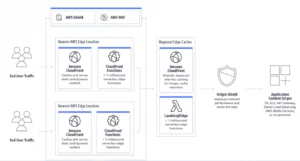Businesses and individuals frequently find themselves having to select from a variety of cloud computing providers in order to fulfill their unique needs. Vultr and Amazon Web Services (AWS) are two prevalent choices in cloud computing industry. AWS is a well-known business juggernaut, but Vultr’s bare metal offering has drawn significant attention for its effectiveness and price. Performance, cost, and support have all been compared in-depth between AWS and Vultr Bare Metal in this post.
Performance
AWS Performance
AWS has a humongous global infrastructure with multiple data centers expansively spread across various regions. This extensive network enables high availability and low latency for applications and services. Here are some key performance features of AWS:
- Elastic Compute Cloud (EC2): AWS EC2 provides scalable virtual machine instances, allowing you to choose from a wide range of instance types optimized for various workloads. These instances are built on AWS’s robust infrastructure, which ensures high performance and reliability.
- Auto Scaling and Load Balancing: AWS offers Auto Scaling and Elastic Load Balancing services, which allow you to automatically adjust resources based on demand and distribute traffic across multiple instances for optimal performance and scalability.
- Content Delivery Network (CDN): AWS CloudFront is a globally distributed CDN service that helps accelerate the delivery of your content, reducing latency and improving user experience.
- Networking Capabilities: AWS provides a range of networking features, like Virtual Private Cloud (VPC), which allows you to create isolated network environments, and Direct Connect, which establishes dedicated network connections between your on-premises infrastructure and AWS data centers.
Vultr Bare Metal Performance
Vultr Bare Metal offers dedicated physical servers without the virtualization layer, providing direct access to the elemental hardware. This can result in enhanced performance and reduced overhead. They are also known as high-frequency servers and deploy high-performance Intel vCPUs. Here are some performance features of Vultr Bare Metal:
- Dedicated Resources: With Vultr Bare Metal, you have exclusive access to the entire server’s resources, ensuring consistent performance and avoiding resource contention that can occur in virtualized environments.
- High-Speed Connectivity: Vultr Bare Metal servers are equipped with high-speed network connections, allowing for low-latency communication and fast data transfer rates.
- Powerful Hardware: Vultr utilizes modern server hardware, including the latest processors, high-capacity storage, and ample memory, to deliver excellent performance for demanding workloads.
- Customization: Vultr Bare Metal allows you to customize the server configuration to meet your particular requirements, enabling you to optimize performance based on your workload needs.
Comparing Performance
Both AWS and Vultr Bare Metal offer high-performance infrastructure, but they have vividly separate approaches. AWS’s virtualized environment provides scalability, flexibility, and a wide range of instance types optimized for various workloads.
On the other hand, Vultr Bare Metal offers dedicated resources and direct access to hardware, which can result in enhanced performance and reduced overhead.
Pricing
AWS Pricing
Amazon Web Services (AWS) offers a complex pricing structure with various pricing models and multiple factors influencing costs. Here are the key components of AWS pricing:
- On-Demand Instances: AWS offers on-demand instances that are billed per hour or per second, depending on the instance type. Pricing can vary based on factors such as instance type, region, and operating system.
- Reserved Instances: AWS also provides the option to reserve instances for a longer duration, such as one or three years, in exchange for discounted hourly rates. Reserved Instances can result in significant cost savings if you have predictable workloads.
- Spot Instances: AWS allows users to bid for spare compute capacity in the AWS cloud, known as Spot Instances. These instances can be significantly cheaper than on-demand instances but are subject to availability and can be terminated if the spot price exceeds your bid.
- Storage and Data Transfer: AWS pricing includes charges for various storage services, such as Amazon S3 for object storage, Amazon EBS for block storage, and Amazon Glacier for long-term archival storage. Data transfer between AWS services and regions also incurs additional costs.


Vultr Bare Metal Pricing
Vultr offers a more straightforward pricing structure compared to AWS. Here’s an overview of Vultr Bare Metal pricing:
- Hourly and Monthly Billing: Vultr provides both hourly and monthly billing options for its Bare Metal instances. Hourly billing is suitable for short-term or flexible workloads, while monthly billing offers a discounted rate for more stable and predictable usage.
- No Data Transfer Fees: Unlike AWS, Vultr does not charge any additional fees for data transfer between Vultr instances and services or between regions.
- Additional Services: Vultr offers additional services like block storage and dedicated cloud firewalls, which have separate pricing based on usage.


Comparing Pricing Models
AWS’s pricing structure is more complex and offers a wide range of options for different use cases. While on-demand instances can be more expensive, utilizing Reserved Instances and Spot Instances can result in significant cost savings. However, the complexity of AWS pricing can make it challenging to accurately estimate and control costs.
Vultr, on the other hand, offers a more transparent pricing model with hourly and monthly billing options. The absence of data transfer fees simplifies cost calculations, making it easier to predict and manage expenses.
Support
AWS Support
AWS is renowned for its extensive support options. They offer multiple levels of support, ranging from basic to premium tiers, each with varying features and response times. Here are some key aspects of AWS support:
- Basic Support: AWS provides free basic support to all customers, which includes access to AWS documentation, community forums, and service health dashboards. However, response times for basic support are not guaranteed.
- Developer Support: This tier offers a more comprehensive level of support, including access to customer service, email support, and a 12-hour response time for non-business critical issues. It also provides general guidance on architectural and best practice recommendations.
- Business Support: Business support offers faster response times (within 1 hour for critical issues) and includes features like chat support during business hours, unlimited support cases, and infrastructure event management.
- Enterprise Support: Designed for large-scale deployments, this premium support tier offers 24/7 access to support engineers, response times within 15 minutes for critical issues, and a dedicated technical account manager. Enterprise support also includes access to AWS Trusted Advisor, which provides recommendations for optimizing your AWS environment.
Vultr Bare Metal Support
Vultr, on the other hand, provides a more simplified support structure compared to AWS. Here’s an overview of Vultr Bare Metal support:
- Documentation and Community: Vultr offers comprehensive documentation and a community forum where users can find self-help resources and tutorials and engage with other users for assistance.
- Ticket Support: Vultr’s primary support channel is through ticket submissions. Customers can open a support ticket for assistance with technical issues or inquiries. Response times of AWS can vary depending on the severity of the issue.
- 24/7 Monitoring: Vultr provides 24/7 monitoring of its infrastructure to proactively address any service disruptions or outages.
Comparing Support Offerings
When it comes to support, AWS undoubtedly has an advantage with its wide range of support tiers, including enterprise-level support for large-scale deployments. AWS support offers faster response times, access to support engineers, and additional features like the Trusted Advisor.
Vultr, on the other hand, focuses on simplicity with its ticket-based support system and self-help resources. While they lack the variety of support tiers offered by AWS, they do provide 24/7 monitoring to ensure the stability of their infrastructure.
Conclusion
The choice between AWS and Vultr should be based on your specific requirements, workload complexity, and the level of support you expect. It is mandatory to analyze the most prominent aspect of support options alongside other factors, such as performance, pricing, and additional services, to make an intelligent decision that aligns with your business goals. To align your company goals with these cloud providers, get acquainted to Nestify that provides services of these cloud providers.
FAQs
Are there any specific use cases where AWS outperforms Vultr Bare Metal or vice versa?
The choice between AWS and Vultr Bare Metal for specific use cases depends on several factors. AWS’s virtualized environment and extensive service offerings make it a perfect choice for a great range of use cases, especially those wanting flexibility, scalability, and access to additional AWS services. Vultr Bare Metal, on the other hand, precedes in resource-intensive workloads that benefit from dedicated physical servers and direct hardware access, such as high-performance databases, gaming servers, or applications that require specialized hardware configurations.
Does AWS’s global network infrastructure provide an advantage in terms of performance?
AWS’s global network infrastructure, with its extensive network of data centers and content delivery network (CDN), can provide lower latency and faster data transfer speeds. This can be advantageous for applications with geographically distributed user bases or those that require high-speed data delivery.
Can Vultr Bare Metal instances be combined with other Vultr services, such as block storage or load balancers?
Yes, Vultr Bare Metal instances can be used in conjunction with other Vultr services. You can attach Vultr Block Storage volumes to your Bare Metal instances to double-up storage capacity, and you can employ Vultr’s Load Balancer service to evenly distribute traffic across multiple Bare Metal servers for improved scalability and availability.
How does AWS’s Auto Scaling feature impact performance?
AWS’s Auto Scaling feature allows you to automatically adjust the number of instances based on demand. This can help optimize performance by ensuring that the resources are scaled up or down to match the workload requirements. Auto Scaling helps maintain performance during peak periods and reduces costs during periods of lower demand.
Does Vultr Bare Metal offer any performance monitoring or analytics tools?
Vultr provides performance monitoring through its control panel, where you can access server statistics, bandwidth usage, and network performance metrics. Additionally, you can integrate third-party monitoring and analytics tools with Vultr Bare Metal instances to gather more detailed performance insights.




